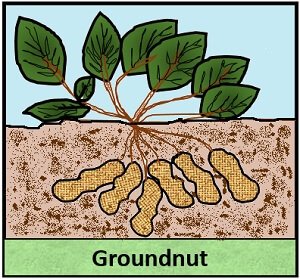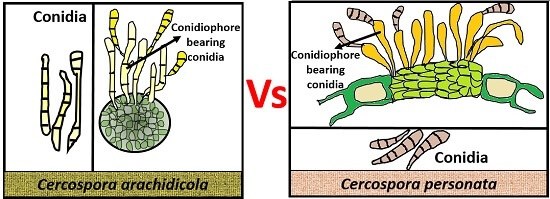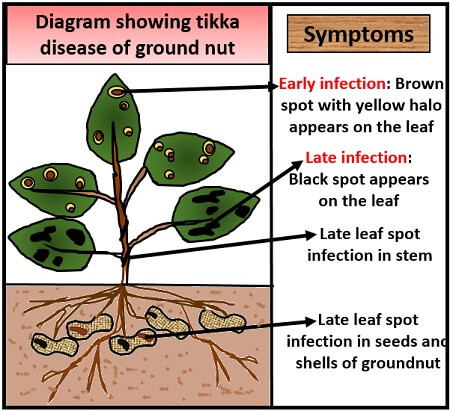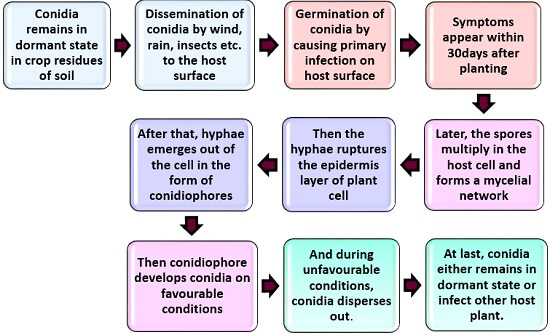Tikka disease of groundnut is a disease also called Leaf spot disease. The causal organism of tikka disease belongs to the genus Cercospora and mainly includes the two species (Cercospora arachidicola and Cercospora personata). Tikka disease cause epidemics in all the groundnut crop growing countries, including the United States, China, India etc. and according to the survey, it can decrease the crop yield by approximately 22%.
Cercospora arachidicola causes Early leaf spot, which is distinguished by the appearance of brown spots with a yellow halo that are few in number and small in size. Cercospora personata causes Late leaf spot, which is identified by the appearance of black spots that are common, more in number and potentially more damaging.
Groundnut: Its biological name is Arachis hypogaea. Groundnut is rich in protein, dietary fibres, fat and other nutrients. According to the studies, groundnut is found to reduce cardiovascular disease. Groundnut is used commercially in many areas like manufacturing of edible oil, in textile industries by the use of its fibres (Ardils), cosmetic industries etc. Therefore, the tikka disease of groundnut can cause huge economic loss by reducing the yield groundnut.

Content: Tikka Disease of Groundnut
- Causal Organism
- Symptoms
- Difference Between Early and Late leaf spot Disease of Groundnut
- Favourable Factors
- Disease Cycle
- Control Measures
Causal Organism of Tikka Disease
The causative agent of tikka disease of groundnut belongs to the genus Cercospora and typically includes two different species, namely Cercospora arachidicola and Cercospora personata.
Classification:
- Kingdom: Fungi
- Phylum: Ascomycota
- Class: Dothideomycetidae
- Order: Capnodiales
- Genus: Cercospora
Distribution: Widespread in tropical countries where the groundnut crop production is more.
Morphological Features of Cercospora arachidicola and Cercospora personata
Cercospora arachidicola and Cercospora personata show the following morphological features:

Mycelium:
- Cercospora arachidicola appears dark brown in colour and grows intracellularly in the plant cell.
- Cercospora personata appears brown-black in colour and first grows intercellularly and later intracellularly.
Haustoria:
- Cercospora arachidicola lacks haustoria.
- Cercospora personata contains branched haustoria.
Conidiophore:
- Cercospora arachidicola consists of continuous, unbranched, yellowish-brown, geniculated and septate (1-2 septa present) conidiophore. It is 22-44 µ long and 3-5 µ wide.
- Cercospora personata consists of continuous, unbranched, light brown in colour, geniculated and aseptate conidiophore. It is 25-54 µ long and 5-8 µ wide.
Conidia:
- Cercospora arachidicola consists of long, cylindrical, hyaline (Pale yellow in colour) conidia. It is 38-108 µ and 6-8 µ wide. The shape of conidia truncates at the base and sub truncates at the apex. Conidia of Cercospora arachidicola are septate, and around 1-12 septa are present.
- Cercospora personata consists of short, cylindrical conidia. It is 18-60 µ and 6-11 µ wide. The shape of conidia is rounded at one end and tapered on the other end. Conidia of Cercospora personata is septate, and around 3-4 septa are present.
Growth:
- Cercospora arachidicola grows intracellularly.
- Cercospora personata first grows intercellularly and later grows intracellularly.
Besides, many differences in the morphology and growth pattern, Cercospora arachidicola and Cercospora personata also share some similarities. Both Cercospora arachidicola and Cercospora personata are pathogenic. The mode of nutrition is saprophytic and parasitic of both Cercospora arachidicola and Cercospora personata.
Symptoms of Tikka Disease of Groundnut

- Cercospora arachidicola cause early leaf spot infection, which includes symptoms like brown-coloured round or oval spots. Yellow halo also appears around the spots in an irregular fashion.
- Cercospora personata cause late leaf spot infection, which includes symptoms like the appearance of the large and dark black-coloured spots on the leaves, stems, seeds and shells of the groundnut.
Difference Between Early and Late Leaf Spot Disease of Groundnut
| Properties | Early leaf spot of groundnut | Late leaf spot of groundnut |
|---|---|---|
| Occurrence | It occurs early | It occurs late |
| Infection | It causes early or primary infections | It causes late or secondary infections |
| Effect | Effects the upper leaves | Effects the lower leaf |
| Spots arrangement | Arranged randomly | Arranged in concentric rings |
| Shape of spot | Circular to irregular | Circular |
| Size of spot | Small | Comparatively larger |
| Colour of leaf spot | Light brown to black spots with yellow halo | Dark brown to black spots |
Favourable Factors
Some environmental and chemical factors favour the incidence of tikka disease in groundnuts, which include:
- Prolonged low temperature
- Heavy dew
- Usage of nitrogen and phosphate fertilizers
Disease Cycle of Tikka Disease
The disease cycle of tikka disease of groundnut is carried out by the fungal spores of the Cercospora species, i.e. Cercospora arachidicola and Cercospora personata.

Initially, the conidia remain in a dormant state within the crop residues of the infected plant. Then, the spores, i.e. conidia of Cercospora sp. disseminate by the factors like wind, rain, insect vectors to the host plant surface.
After that, the conidia germinate on the favourable conditions and result in a germ tube formation, by entering into the plant cell through the stomatal pores. There it causes primary infection on the host surface, and the symptoms appear within 30days after planting.
Then the spores multiply and form a high number of hyphae or a mycelial network. These hyphae then rupture from the epidermis wall of the plant cell and emerge out as the long conidiophores.
These conidiophores then develop spores, i.e. conidia on the favourable conditions. After that, the conidia detach from the conidiophore by some unwanted factors like wind, rain splashing etc.
Then after detachment, the conidia will either remain at a dormant state in the soil, or it can infect the other host plant. Therefore, the disease cycle continues like this way only.
Control Measures
Management of early tikka disease of groundnut: The early infections of tikka disease can be managed by the following ways, which includes:
- Crop rotation
- Eradication of infected plants by burning or burying them in deep pits.
- Pruning can also be done with the help of pruning scissors by removing the infected parts of the plant.
- The seeds of groundnut that are within the shells can be disinfected with sulphuric acid, and those are without the shell can be treated for half an hour with 0.5% of copper sulphate solution.
- Raw seeds after dressing with Agrosan GN can also reduce the chances of infection.
Management of late tikka disease of groundnut: The late infections of tikka disease can be only managed by the use of effective fungicides like Bordeaux mixture as a spray.